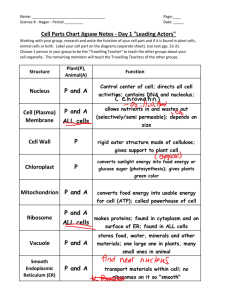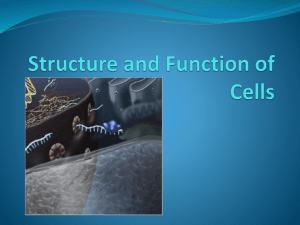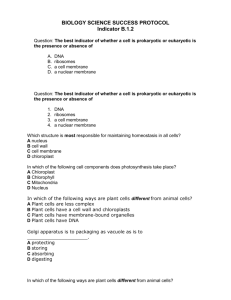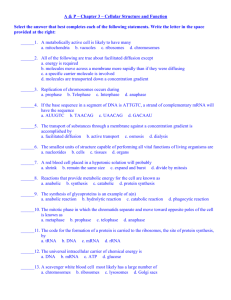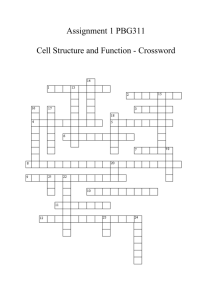cell - Wikispaces
advertisement
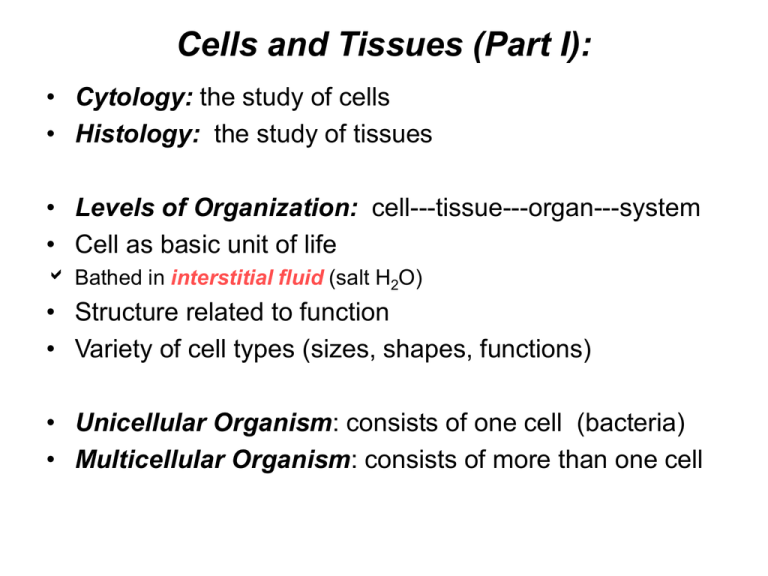
Cells and Tissues (Part I): • Cytology: the study of cells • Histology: the study of tissues • Levels of Organization: cell---tissue---organ---system • Cell as basic unit of life Bathed in interstitial fluid (salt H2O) • Structure related to function • Variety of cell types (sizes, shapes, functions) • Unicellular Organism: consists of one cell (bacteria) • Multicellular Organism: consists of more than one cell • Prokaryotic Cell (Prokaryote): primitive Nuclear material spread out No nuclear membrane Examples: Bacteria and blue-green algae • Eukaryotic Cell (Eukaryote): advanced Nuclear material confined within a nuclear membrane Examples: All cells except bacteria and blue-green algae • Characteristics of Cells: Nutrition: involves the cell’s need for taking in food Digestion: the breakdown of food Reproduction: to make a copy Cellular Respiration: food being changed into energy Excretion: getting rid of wastes Secretion: to release a product Synthesis: to make a product Irritability: response • Cell Theory: • Schleiden (1804-1881); Schwann (1810-1882) All living things are composed of cells. All cells are similar in structure and function. The structure and function of an organism involves the organization and action of all its cells. All cells come from pre-existing cells (Virchow) • Exceptions: Viruses Cell parts that reproduce (mitochondria, chloroplasts) Not all cells are separated by a cell membrane (muscle) Cell Biology Discoveries: • Robert Hooke (1665): coined the term “cell ” (cork) • DuJardin: discovered cytoplasm • Robert Brown: discovered the nucleus Cell Organelles (Cell Parts): • Protoplasm: a clear jelly-like material (colloid) Contains H2O, wastes, nutrients Cytoplasm: protoplasm within the cell membrane Keeps the cell hydrated Nucleus • “Control Center” Controls everything in the cell Contains DNA • Has a double-layered membrane with pores • Shape of nucleus conforms to the shape of the cell • Contains nucleoplasm Chromosomes • Control heredity • Threads in the nucleus • Contain DNA • Human Body Cell (46) • Human Sex Cell (23) • Chromatin: inactive (non-dividing genetic material) Nucleolus • “Ribosome Factory” • 1-4 in the nucleus • Make ribosomes Centrioles • Involved in cellular reproduction • Only in animal cells • Rods outside the nucleus • Made up of fine microtubules • Hold up each end of the mitotic spindle Mitochondria • “Powerhouse of the Cell” • Involved with energy/ metabolism/cellular respiration/form ATP • Contains cristae hold enzymes increase surface area Ribosomes • Made by the nucleolus • Involved in protein synthesis • Attached: on ER (protein sent out of the cell) • Floating: in the cell (protein within the cell) • Made up of RNA Endoplasmic Reticulum • Channel inside the cell • Rough ER: contains ribosomes (protein sent out of the cell) • Smooth ER: does not contain ribosomes (fats sent out of the cell) Golgi Bodies • “Packaging Center” • Stack of coins • Secretion Secretion Vacuoles • Clear bubbles • Hold Water • Prevent dehydration • Animal (small, several) • Plant (few, large) Lysosomes • “Suicide Sacks” (membrane made fragile by high amounts of vitamin A) • Contain digestive enzymes Act as scavengers Eat old cell parts • Related to aging, arthritis? Peroxisomes • “Detox Units” Filters all poisons Change free radicals to H2O2 Enzyme catalase converts H2O2 to H2O • High number in kidneys and liver • Tiny bubbles Microtubules/Microfilaments • “Skeleton of the Cell” • Microtubules (support or shape); mini tubes • Microfilaments (cell movement); threads • Intermediate filaments: Help to form desmosomes Plant Cell • Cell Wall (to prevent dehydration) • Chloroplasts (contain chlorophyll) Green organelles Involved in photosynthesis • Large Vacuoles Cell Membrane: • • Surrounds both animal and plant cell to prevent dehydration Semi-Permeable Membrane: Contains pores Some particles move inside the cell; Some particles move out of the cell; Cell membrane is selective Movement depends on: size of particles, chemistry of particles, temperature, pressure • Sandwich Model (1935): Static model 2 phospholipid layers (phosphate + fat) between 2 layers of protein • Fluid Mosaic Model (1970): Dynamic model Proteins immersed in the 2 layers of phospholipids (fluid) Specializations of the Cell membrane: • Gap Junctions: allow communication between cells (heart, embryonic cells) • Microvilli: fingerlike projections that increase absorption • Desmosomes: buttonlike thickenings which aid in protection from mechanical stress • Tight Junctions: zipperlike; leakproof Movement of Molecules: • Passive Transport: No energy required Movement from a high concentration to a low concentration • Diffusion: A type of passive transport Movement of molecules from a high concentration to a low concentration • Osmosis: A type of passive transport Movement of H2O molecules from a high concentration to a low concentration (down a concentration gradient) through a membrane • Facilitated Transport: Use of carrier proteins which carry molecules through the membrane • Filtration: Process by which H2O and solutes are forced through a membrane (or capillary wall) by fluid, or hydrostatic pressure (usually exerted by the blood) Uses a pressure gradient to push solute-containing fluid from a higher-pressure area to a lower-pressure area Not a very selective process Necessary for the kidneys to operate Types of Solutions: • Isotonic Solution: • Concentration of solute (dissolved materials) in the solution = the concentration of dissolved materials inside the cell The concentration of H2O in the solution = the concentration of H2O inside the cell Cells retain their normal shape • Hypertonic Solution: • Concentration of solute (dissolved materials) outside the cell is higher than the concentration of dissolved materials inside the cell There is more H2O inside the cell than outside the cell H2O will move out of the cell Pressure decreases and the cell shrivels • Animal cell: Cell shrivels up (Plasmolysis) • Plant cell: Cell membrane and cytoplasm pull away from the cell wall; Plant wilts • Hypotonic Solution: • Concentration of solute (dissolved materials) is lower in the solution outside the cell than the concentration of dissolved materials inside the cell There is more H2O outside the cell than inside the cell H2O will move into the cell Pressure increases and the cell swells • Animal Cell: Cell could burst (Cytolysis) • Plant Cells: Cell wall prevents cytolysis; high turgor pressure and plant cell becomes firm (stiff) • Active Transport: Energy (AP) required Movement of molecules from a low concentration to a high concentration Called solute pumping Nerve cells with Sodium (out) – Potassium (in) Pump • Bulk transport: movement of large molecules across the membrane • Endocytosis: movement of large molecules into the cell Pinocytosis: “cell drinking”; taking in liquid and forming a vacuole Phagocytosis: “cell eating”: taking in a solid particle; dissolved by digestive enzymes of a lysosome Exocytosis: movement of large molecules out of the cell Preparation of a Wet Mount: • Place a drop of H2O on a clean slide • Place the specimen in the drop of H2O • Add stain (emphasizes cell parts) • Place cover slip over specimen at a 450 angle • Press out bubbles on the cover slip Lab Techniques: • Growing cells on glass (cell culture) Cell food (medium) • Cell Fractionation: separation of cell parts by high velocity (20,000X/min.) using a centrifuge Most dense cell parts settle to the bottom of the test tube • Autoradiography: injecting radioactive isotopes into cells/organisms as tracers Cell Division • Mitosis: occurs in somatic cells; 1 2 • Cell Cycle continuous; Varies in different tissues at different times • Interphase: G1, G2 (gap): Cell duplicates specific protein molecules S (synthesis): replicates genetic material Mitosis • Why do cells divide? The larger the cell, the more demands are placed on its DNA Trouble with a larger cell moving nutrients and wastes across the cell membrane • Cell Cycle: the sequence of growth (preparation) and division of a cell • Accurate cell division and regulation of the cell cycle is critical to the health of the cell Mistake in cell cycle can lead to cancer (uncontrolled cell division) • Guarantees genetic continuity, growth, repair Stages of Mitosis: Interphase • DNA doubles • Centrioles double • Chromosomes difficult to see (dots) • Nucleolus and nuclear membrane visible • “Resting Stage” Prophase • Longest Stage • Chromosomes long and thin • Nucleolus and nuclear membrane disappear • Spindle forms • Centromere hooks doubled chromosomes to the spindle • Centrioles at both ends of the spindle Metaphase • Middle Stage • Shortest Stage • Doubled chromosomes line up at equator Anaphase • Chromosomes pull apart to opposite poles Telophase • Last Stage of Mitosis • Animal Cell breaks apart • Plant Cell breaks apart • Result: 2 identical daughter cells Deoxyribonucleic Acid (DNA) • The ‘blueprint of life” • Unique and unrepeatable • Located in genes Genes make up chromosomes Chromosomes in the nucleus of the cell • DNA composed of units called nucleotides Each nucleotide is made up of a sugar, phosphate, and hydrogen base. • Double Helix model of Watson and Crick • X ray photos by Rosalind Franklin • Sides of ladder (S-P) with covalent bonds • Sugar: deoxyribose • Steps of ladder (bases) • Complementary Base Pairs Purines (Adenine/Guanine) Pyrimidines (Cytosine/Thymine) A-T (2 hydrogen bonds) C-G (3 hydrogen bonds) The Race for the DNA Model King’s College London Cavendish Lab London Rosalind Franklin James Watson Francis Crick (X ray Diffraction Studies) Photo #51 Maurice Wilkins Nobel Prize 1962 (Double Helix Model) • Mutation: a mistake in nitrogen base pairs • Pattern of bases codes for a specific amino acid • Codon: 3 letter (bases) code for 1 amino acid • Replication of DNA (Making an identical copy) DNA unzips and hydrogen bases separate (action of DNA polymerase) Free-floating nucleotides match up on each side Hydrogen bonds reform Result: 2 identical DNA molecules (Each contain 1 of the original DNA strands) Semi-Conservative Model of Replication • Each DNA molecule with a new strand and an old strand • DNA never leaves the nucleus Ribonucleic Acid (RNA) • • • • • • Made up of nucleotides Sugar called ribose Nitrogen Bases: A, C,G,U Single-stranded Located in the nucleus and in the ribosomes 3 Types: Messenger RNA (mRNA); carries message of DNA to ribosomes (3 letter code – codon); single strand of letters Transfer RNA (tRNA): reads the mRNA code at the ribosomes (3 letter code – anticodon); carries an amino acid; shamrock shape Ribosomal RNA (rRNA): joins mRNA to tRNA Transcription • Making of mRNA from one side of DNA in nucleus DNA polymerase unzips DNA Hydrogen bonds break and energy is released One side of DNA acts as a “template” (model) for making mRNA Free-floating nucleotides line up and form mRNA DNA reforms mRNA carries the message of DNA to ribosomes Translation • Occurs at the ribosomes • Anticodon of tRNA joins with codon of mRNA (rRNA helps) • Amino acid pops off end of tRNA • Amino acids string together to form a protein (Protein Synthesis)
